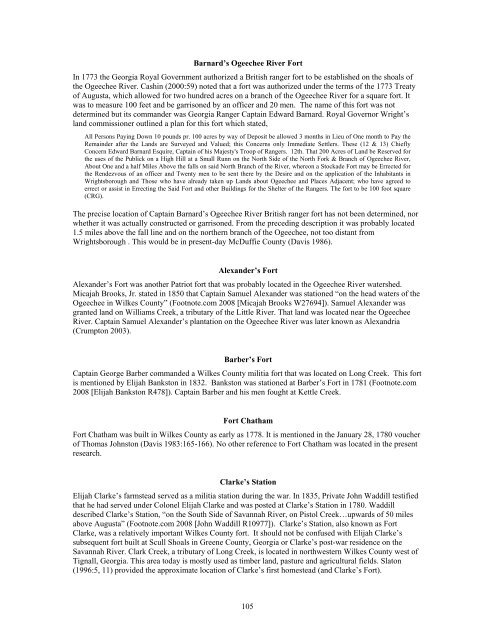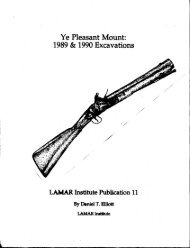Stirring Up a Hornet's Nest: - UGA Laboratory of Archaeology ...
Stirring Up a Hornet's Nest: - UGA Laboratory of Archaeology ...
Stirring Up a Hornet's Nest: - UGA Laboratory of Archaeology ...
You also want an ePaper? Increase the reach of your titles
YUMPU automatically turns print PDFs into web optimized ePapers that Google loves.
Barnard’s Ogeechee River Fort<br />
In 1773 the Georgia Royal Government authorized a British ranger fort to be established on the shoals <strong>of</strong><br />
the Ogeechee River. Cashin (2000:59) noted that a fort was authorized under the terms <strong>of</strong> the 1773 Treaty<br />
<strong>of</strong> Augusta, which allowed for two hundred acres on a branch <strong>of</strong> the Ogeechee River for a square fort. It<br />
was to measure 100 feet and be garrisoned by an <strong>of</strong>ficer and 20 men. The name <strong>of</strong> this fort was not<br />
determined but its commander was Georgia Ranger Captain Edward Barnard. Royal Governor Wright’s<br />
land commissioner outlined a plan for this fort which stated,<br />
All Persons Paying Down 10 pounds pr. 100 acres by way <strong>of</strong> Deposit be allowed 3 months in Lieu <strong>of</strong> One month to Pay the<br />
Remainder after the Lands are Surveyed and Valued; this Concerns only Immediate Settlers. These (12 & 13) Chiefly<br />
Concern Edward Barnard Esquire, Captain <strong>of</strong> his Majesty's Troop <strong>of</strong> Rangers. 12th. That 200 Acres <strong>of</strong> Land be Reserved for<br />
the uses <strong>of</strong> the Publick on a High Hill at a Small Runn on the North Side <strong>of</strong> the North Fork & Branch <strong>of</strong> Ogeechee River,<br />
About One and a half Miles Above the falls on said North Branch <strong>of</strong> the River, whereon a Stockade Fort may be Errected for<br />
the Rendezvous <strong>of</strong> an <strong>of</strong>ficer and Twenty men to be sent there by the Desire and on the application <strong>of</strong> the Inhabitants in<br />
Wrightsborough and Those who have already taken up Lands about Ogeechee and Places Adjacent; who have agreed to<br />
errect or assist in Errecting the Said Fort and other Buildings for the Shelter <strong>of</strong> the Rangers. The fort to be 100 foot square<br />
(CRG).<br />
The precise location <strong>of</strong> Captain Barnard’s Ogeechee River British ranger fort has not been determined, nor<br />
whether it was actually constructed or garrisoned. From the preceding description it was probably located<br />
1.5 miles above the fall line and on the northern branch <strong>of</strong> the Ogeechee, not too distant from<br />
Wrightsborough . This would be in present-day McDuffie County (Davis 1986).<br />
Alexander’s Fort<br />
Alexander’s Fort was another Patriot fort that was probably located in the Ogeechee River watershed.<br />
Micajah Brooks, Jr. stated in 1850 that Captain Samuel Alexander was stationed “on the head waters <strong>of</strong> the<br />
Ogeechee in Wilkes County” (Footnote.com 2008 [Micajah Brooks W27694]). Samuel Alexander was<br />
granted land on Williams Creek, a tributary <strong>of</strong> the Little River. That land was located near the Ogeechee<br />
River. Captain Samuel Alexander’s plantation on the Ogeechee River was later known as Alexandria<br />
(Crumpton 2003).<br />
Barber’s Fort<br />
Captain George Barber commanded a Wilkes County militia fort that was located on Long Creek. This fort<br />
is mentioned by Elijah Bankston in 1832. Bankston was stationed at Barber’s Fort in 1781 (Footnote.com<br />
2008 [Elijah Bankston R478]). Captain Barber and his men fought at Kettle Creek.<br />
Fort Chatham<br />
Fort Chatham was built in Wilkes County as early as 1778. It is mentioned in the January 28, 1780 voucher<br />
<strong>of</strong> Thomas Johnston (Davis 1983:165-166). No other reference to Fort Chatham was located in the present<br />
research.<br />
Clarke’s Station<br />
Elijah Clarke’s farmstead served as a militia station during the war. In 1835, Private John Waddill testified<br />
that he had served under Colonel Elijah Clarke and was posted at Clarke’s Station in 1780. Waddill<br />
described Clarke’s Station, “on the South Side <strong>of</strong> Savannah River, on Pistol Creek…upwards <strong>of</strong> 50 miles<br />
above Augusta” (Footnote.com 2008 [John Waddill R10977]). Clarke’s Station, also known as Fort<br />
Clarke, was a relatively important Wilkes County fort. It should not be confused with Elijah Clarke’s<br />
subsequent fort built at Scull Shoals in Greene County, Georgia or Clarke’s post-war residence on the<br />
Savannah River. Clark Creek, a tributary <strong>of</strong> Long Creek, is located in northwestern Wilkes County west <strong>of</strong><br />
Tignall, Georgia. This area today is mostly used as timber land, pasture and agricultural fields. Slaton<br />
(1996:5, 11) provided the approximate location <strong>of</strong> Clarke’s first homestead (and Clarke’s Fort).<br />
105










